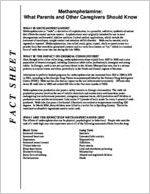Methamphetamine: What Parents and Other Caregivers Should Know
FACT SHEET
WHAT IS METHAMPHETAMINE?
Methamphetamine or "meth", a derivative of amphetamine, is a powerful, addictive, synthetic stimulant that affects the central nervous system. Amphetamines were originally intended for use in nasal decongestants and bronchial inhalers and have limited medical applications, which include the treatment of narcolepsy, weight control and attention deficit disorder. Meth can be snorted, orally ingested or injected. Methamphetamine, also called crank, glass, crystal, chalk or speed comes in a powder form that resembles granulated crystals and in a rock form known as "ice," which is a smoked form of meth that came into use during the late 1980s.
WHAT IS THE IMPACT ON GEORGIA COMMUNITIES?
Once thought to be a blue-collar drug, methamphetamine abuse tripled from 1997 to 2003 and a new population of abusers emerged, including Caucasian white-collar professionals, teenagers and young adults. In Georgia, meth is not yet a primary threat in the Atlanta Metropolitan area, but is a serious problem in smaller towns and cities, particularly in the North and Central regions of the state.
Admissions to publicly funded programs for methamphetamine use increased from 263 in 1999 to 953 in 2001, according to the Georgia Drug Threat Assessment published by the National Drug Intelligence Center (NDIC). Meth use has also had an impact on the law enforcement community. Officers shut down 29 meth labs in 1999 and raided 439 labs in the first nine months of 2003.
Methamphetamine production also poses a safety concern in Georgia communities. The meth lab production process involves the use of volatile chemicals and creates toxic and hazardous waste endangering law enforcement personnel, emergency response teams, child protection staff children in production areas and the environment. Labs create 5-7 pounds of toxic waste for every 1-pound of meth produced. Meth labs also pose a fire hazard. Chemicals are cooked at temperatures exceeding 200 degrees. In March 2004, three children were killed in a trailer fire in Spalding County. The trailer contained combustible ingredients used to make meth.
WHAT ARE THE EFFECTS OF METHAMPHETAMINE USE?
The effects of methamphetamine can be physical, psychological or behavioral. People who seek the rush of a meth high may also experience one or all of the following unwanted effects from the drug.
Short Term
Increased alertness Increased heart rate Depression Increased sexual arousal Violent behavior Sleep deprivation Excessive talking Sores from scratching Hallucinations
Long Term
Insomnia Uncontrollable anxiety Hyperactivity Addiction Panic attacks Lead and strychnine poisoning Malnutrition Abused and neglected children Death
Methamphetamine: What Parents and Other Caregivers Should Know
Page Two
HOW SHOULD WE CARE FOR CHILDREN EXPOSED TO METHAMPHETAMINE?
People who manufacture methamphetamine in their homes often have children. According the Drug Enforcement Agency (DEA), police have found 113 children living in homes used as meth labs in Georgia. Children of meth addicts face a variety of problems, some similar to other children of addicted parents and some unique to meth. Many of the children taken from homes where meth was present are severely malnourished and may lack many basic skills. For children exposed to the toxic drugs there are problems with hyperactivity, impulsivity and probable long-term disabilities.
When a child has been recently exposed to a methamphetamine lab, within the past 72 hours, the risk to caregivers, their families and other placement providers is minimal. The child has been assessed, based on the circumstances at the site of exposure, and washed if necessary. Unfortunately, because of concerns of possible chemical contamination, children exposed to meth labs must leave behind some or all of their personal belongings if it is unclear how heavily they are contaminated with chemical residues. Caregivers should anticipate this and continue to work with social service agencies to ensure children have what they need: items such as clothing, stuffed animals, toys, and the like.
As a caregiver of a child exposed to meth and chemicals used in its production, it is extremely important to have enough information. Make sure the social service worker provides you with information about the extent of the child's exposure to chemicals and/or toxins, a description of what medical treatment they have received prior to placement, and information on follow-up medical appointments that may be necessary. It is extremely important to monitor a child's health and development, as some effects may not be seen immediately. Seek medical attention if a child experiences breathing or nervous system problems, including headaches, drowsiness, or difficulty breathing. Also, if the child's development seems behind for his or her age, the child's doctor should be consulted for further evaluation.
It's likely that the circumstances of the discovery of the illegal methamphetamine laboratory and removal have been traumatic for the child. Often, labs are seized in police raids and analyzed by people in hazardous material suits. One or more parents may have been arrested. In addition, the child may have been neglected in their previous home, or subjected to physical or sexual abuse. Caregivers should ensure the child has a warm, stable environment and be prepared for emotional reactions from the child that may follow placement.
WHERE CAN YOU GO FOR ADDITIONAL INFORMATION ON METH USE
Georgia Poison Center Hughes Spalding Children's Hospital Grady Health System 80 Jesse Hill Drive, SE P.O. Box 26066 Atlanta, Georgia 30335-3801 Emergency Phone: 800-222-1222 TTY/TDD: 404-616-9287 Website: www.gpc.dhr.georgia.gov
Georgia Department of Human Resources Division of Public Health 2 Peachtree Street, NW Atlanta, Georgia 30303-3142
Georgia Meth Watch Program: www.gameth.com National Clearinghouse for Alcohol Drug Information: www.health.org National Institute on Drug Abuse (NIDA): www.drugabuse.gov
